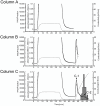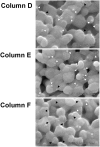Scanning electron microscopy-based approach to understand the mechanism underlying the adhesion of dengue viruses on ceramic hydroxyapatite columns
- PMID: 23326529
- PMCID: PMC3542262
- DOI: 10.1371/journal.pone.0053893
Scanning electron microscopy-based approach to understand the mechanism underlying the adhesion of dengue viruses on ceramic hydroxyapatite columns
Abstract
Although ceramic hydroxyapatite (HAp) chromatography has been used as an alternative method ultracentrifugation for the production of vaccines, the mechanism of virus separation is still obscure. In order to begin to understand the mechanisms of virus separation, HAp surfaces were observed by scanning electron microscopy after chromatography with dengue viruses. When these processes were performed without elution and with a 10-207 mM sodium phosphate buffer gradient elution, dengue viruses that were adsorbed to HAp were disproportionately located in the columns. However, when eluted with a 10-600 mM sodium phosphate buffer gradient, few viruses were observed on the HAp surface. After incubating the dengue viruses that were adsorbed on HAp beads at 37°C and 2°C, the sphericity of the dengue viruses were reduced with an increase in incubation temperature. These results suggested that dengue virus was adsorbed to the HAp surface by electronic interactions and could be eluted by high-salt concentration buffers, which are commonly used in protein purification. Furthermore, virus fusion was thought to occur with increasing temperature, which implied that virus-HAp adhesion was similar to virus-cell adhesion.
Conflict of interest statement
Figures





Similar articles
-
Surface-layer modification of hydroxyapatite ceramic with acid and heat treatments.Dent Mater J. 2002 Jun;21(2):170-80. doi: 10.4012/dmj.21.170. Dent Mater J. 2002. PMID: 12238785
-
Nano-sized ceramic particles of hydroxyapatite calcined with an anti-sintering agent.J Nanosci Nanotechnol. 2007 Mar;7(3):848-51. doi: 10.1166/jnn.2007.505. J Nanosci Nanotechnol. 2007. PMID: 17450845
-
Separation of monoclonal antibody monomer-dimer mixtures by gradient elution with ceramic hydroxyapatite.J Chromatogr A. 2020 Oct 11;1629:461465. doi: 10.1016/j.chroma.2020.461465. Epub 2020 Aug 14. J Chromatogr A. 2020. PMID: 32827903
-
[Synthesis and characteristics of porous hydroxyapatite bioceramics].Sheng Wu Yi Xue Gong Cheng Xue Za Zhi. 2002 Jun;19(2):302-5. Sheng Wu Yi Xue Gong Cheng Xue Za Zhi. 2002. PMID: 12224306 Review. Chinese.
-
Permanently polarized hydroxyapatite, an outstanding catalytic material for carbon and nitrogen fixation.Mater Horiz. 2022 Jun 6;9(6):1566-1576. doi: 10.1039/d1mh02057a. Mater Horiz. 2022. PMID: 35357375 Review.
Cited by
-
Nanostructured platforms for the sustained and local delivery of antibiotics in the treatment of osteomyelitis.Crit Rev Ther Drug Carrier Syst. 2015;32(1):1-59. doi: 10.1615/critrevtherdrugcarriersyst.2014010920. Crit Rev Ther Drug Carrier Syst. 2015. PMID: 25746204 Free PMC article. Review.
-
Waiting for Aπαταω: 250 Years Later.Found Sci. 2019 Dec;24(4):617-640. doi: 10.1007/s10699-019-09602-x. Epub 2019 Apr 3. Found Sci. 2019. PMID: 31938016 Free PMC article.
-
Calcium Phosphate as a Key Material for Socially Responsible Tissue Engineering.Materials (Basel). 2016 Jun;9(6):434. doi: 10.3390/ma9060434. Epub 2016 Jun 1. Materials (Basel). 2016. PMID: 27347359 Free PMC article.
-
The Role of Hydroxyl Channel in Defining Selected Physicochemical Peculiarities Exhibited by Hydroxyapatite.RSC Adv. 2015;5:36614-36633. doi: 10.1039/C4RA17180B. RSC Adv. 2015. PMID: 26229593 Free PMC article.
-
Biodegradable, Efficient, and Breathable Multi-Use Face Mask Filter.Adv Sci (Weinh). 2021 Jan 29;8(6):2003155. doi: 10.1002/advs.202003155. eCollection 2021 Mar. Adv Sci (Weinh). 2021. PMID: 33747729 Free PMC article.
References
-
- Morenweiser R (2005) Downstream processing of viral vectors and vaccines. Gene Ther Suppl 1: S103–10. - PubMed
-
- Iyer G, Ramaswamy S, Asher D, Mehta U, Leahy A, et al. (2011) Reduced surface area chromatography for flow-through purification of viruses and virus like particles. J Chromatogr A 1218: 3973–3981. - PubMed
-
- Sugo K, Ogawa T (2007) Three-dimensional culture of rat bone marrow cells using hydroxyapatite microcarrier. Tiss Cult Res Commun 26: 125–131.
MeSH terms
Substances
LinkOut - more resources
Full Text Sources
Other Literature Sources

